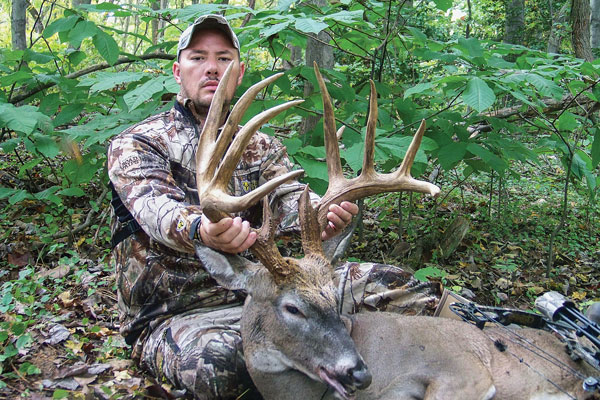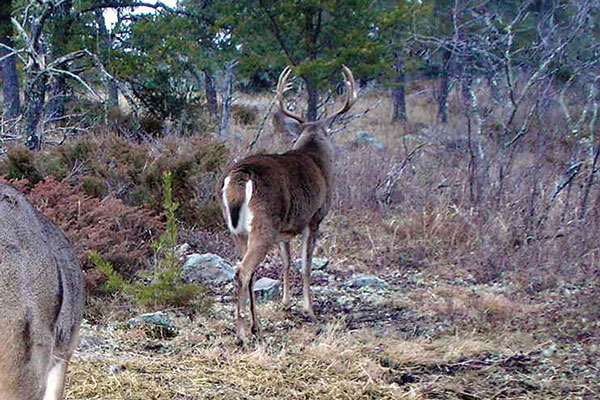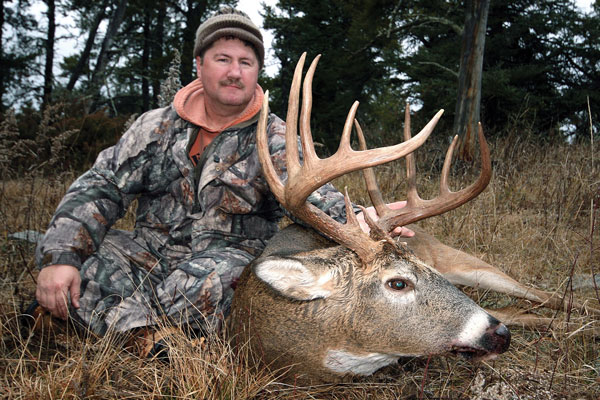By Dan Cole

The most consistent trophy hunters we read about in story after story all have two things in common. First, they're students of the whitetail. And nothing can replace or trump knowledge. Second, they ardently pay attention to details; they let nothing get past them.
They don't rely on gadgets, gimmicks or sheer hope. They rely on their knowledge and the intricate details of the deer they're hunting. While the equipment we all use has improved greatly over the years, these experts have taught us that even with the best gear, consistent success still takes using your brain.
But what if I told you there's a "secret" technique: a proven strategy that, while unknown to the average hunter, has led to the taking of many giant whitetails? It's probably been responsible for the demise of thousands of mature bucks over the past few decades, including some of the largest ever recorded. Would that grab your attention?
Advertisement
Well, it's true. And what I'm about to share with you offers a realistic promise of revolutionizing your hunting future.
Background
I've been a record-book measurer for 25 years, traveling to countless hunting shows and deer classics over this time. I also traveled for eight years with a trophy whitetail display, taking it to hundreds of fairs and outdoors shows across the U.S.
I bring this up just to point out that I've had the opportunity to talk with probably hundreds of thousands of hunters over the course of those years. And in the process, I quickly picked up on a common theme that was being repeated across the whitetail's range. Hunters far and wide have been spotting, hunting and consistently killing mature bucks on a pattern they noticed a year ahead of time.
Advertisement
From folks who'd shot great bucks I was continually hearing such things as, "It was a year to the day after we'd first seen him." Or, "I got him within 100 yards of where he stood the year before." Or, "Same date as last year, when we first saw him." I heard comments like these far too often for it to be pure coincidence.
When I compared those conversations with my personal hunting notes and trail camera photos, it became very apparent to me that a pattern of consistent opportunity was being presented by mature whitetails. Let's look into what I now refer to as "The 7-Day Rule."
Most of us would agree that whitetails are creatures of habit. Given a stable environment with no pressure influences, a deer, whether young or mature, can be counted on to predictably stay within a relatively tight schedule. Of course, what it does on any given day is generally influenced by wind direction, available food, terrain features, time of year and disturbance, such as from predators and/or human intrusion.
When influences such as wind, habitat and hunting pressure remain relatively the same year to year, there develops a pattern a hunter can use to intercept mature bucks. Year after year, the same buck will visit the same areas. He'll use the same trails and scrapes. And he'll do all of this at relatively the same times each year — often right down to the same date and sometimes even the same hour!
I'm talking about a specific 7-day period during which in many cases a buck is repeating his travel location and pattern, sometimes for several years straight. As noted, this is far more than a theory — it's an actual pattern that has proved itself accurate and dependable on many mature bucks. And once you learn it, your approach to hunting big whitetails will forever be changed.
How It Works
In theory, The 7-Day Rule works like as follows. A good buck walks along a certain trail and visits a scrape, and you either see him or get him on trail camera. One year from that date, he should be visiting the same scrape and walking along the same trail. That's the premise. If all of the mentioned influences remain the same, or relatively so, the buck will be on this same predictable travel pattern within the same week year after year.
Believe me, as far-fetched as that might seem, the proof of the pattern is found throughout the pages of most whitetail record books.

Let's say you got a daylight photo of a good buck on Nov. 5 last year. He was working his way along a ridgetop, and the wind was from the south. Advance your calendar one year and use Nov. 5, 2014, as the center of a 7-day period. With a south wind and all other influences remaining largely the same, that buck — if he's still alive, of course — will be on that same ridge, in daylight, sometime between Nov. 2 and Nov. 8.
You might not be able to kill the deer in the exact spot in which you documented him, but that's where your post-season scouting comes in. By following the ridge and using backtracking and sign-reading methods, you should be able to find a daylight intercept point that will enable you to have an opportunity at the buck.
Here's a great example of how The 7-Day Rule played out over a span of three seasons where I hunt in Northwest Ontario. The area is almost solid forest with no agriculture, though I wouldn't classify it as true wilderness.
It began in 2008, my second year of hunting this particular area. At 1:05 p.m. on Nov. 13, a beautiful 3 1/2-year-old, 135-class buck walked within 25 yards of my ground blind. I was in the blind at the time but let the buck pass. He was certainly a nice deer and one I wanted to see in the future.
That night, a quick search through my photo files confirmed this was the first time I'd documented this particular deer. I made the entry in my journal and added wind direction and speed, time of day and weather observations, as I always do.
In November 2009 I was back in the same area, but this time I tagged out (on another buck) on Nov. 11. I was packed up and heading home by midday on the 12th — but as usual, I left my trail cameras running. One thing I've always enjoyed doing is leaving them out over the winter, in this area usually over mock scrapes.
Because of winter conditions and distance from my home, I rarely retrieve the cameras before spring. And that was true in this instance. April 2010 found me once again back in the area, this time for the purpose of a shed hunt and to do some scouting.
Naturally, while there I retrieved my cameras. Later that evening, I was going through the photos when I noticed a beautiful buck in one of the pictures. He was a tall 10-pointer that would score around 150 inches, and it took me all of 30 seconds to realize he was the same buck I'd seen in 2008. The date on the photo was Nov. 14, 2009, and the time stamp read 1:15 p.m. — a year, a day and 10 minutes after I'd seen the deer in the same spot while in my ground blind.
In fall 2010 I had great expectations, as I had two bucks I was looking forward to hunting. One was the 10-pointer, which I now affectionately called "Drifter." I figured he was now a 5 1/2-year-old and prime for taking. But I didn't wait for an encounter with him. Instead, I filled my tag without hesitation on the second "hit list" buck, a beautiful 162-inch 11-pointer.
Once again, I was packed up and gone on the morning of Nov. 13, but not before setting up my cameras for another winter "soak." Checking them the following spring, I was surprised and elated to see a photo of Drifter standing squarely in the middle of a mock scrape.
I'd taken a great buck that past November, one I'll be proud of for the rest of my life. But the camera showed that two days later and 30 yards from where I'd killed him, there stood Drifter — all 170 inches of him! And his visit was right on schedule: Nov. 14 at 1:05 p.m. He'd hit the scrape a year to the minute after I'd documented him there before!
Ultimately, my elation over Drifter's rock-steady pattern turned to disappointment, for that would be my last photo of him. The winter was extremely harsh, even by that region's standards. He evidently didn't survive one of the many storms, or perhaps the local wolf pack caught up to him. Regardless, his pattern held true. In three years I'd snapped 12 trail camera photos of him: all within the same 24-hour period, all during midday and all within the same 100-square-yard area. And the majority of those photos were taken between 1:00 and 1:45 p.m.
Coincidence, you say? Well, the 162-inch buck I took in 2010 can be photo traced for four years with daylight photos, all within a 50-square-yard area, and all on Nov. 11! So it wasn't by chance I killed one of these deer. I went into that season fully confident that I'd leave with one of them. Either was fine with me.
Need more proof? Joshua Bruce took an immense, 250-plus-inch Mississippi non-typical exactly one year from the day he first saw the buck. And he killed the deer within 100 yards of where the sighting had taken place the year before — and at almost the exact same time of day!
Another friend, Keith Snider, capitalized on sighting a huge buck in a secluded meadow in southeastern Ohio. One year to the day and only a few minutes difference in time later, he was able to tag his biggest deer to date. Again, similar scenarios have played out thousands of times for hunters in a number of places.
Making it Happen
Finding a mature buck to pattern is the most important part of The 7-Day Rule. But again, that doesn't mean all you have to do is simply set up in that spot a year later to kill him. You still need to use all of your hunting skills and put your sign reading to the test.

As mentioned, where the buck was spotted isn't always where you can or will kill him. You might need to backtrack him or follow his sign to a more appropriate location. And you might have only night photos and thus need to find a spot where he'll be during legal shooting light. You might also need to find a spot where there's a tree suitable for a stand.
Any buck can be tracked forward or backward by the line of sign or terrain features he's following. A serious trophy hunter will pay attention to all sightings, no matter the time of day or night. If the deer is spending the day on land you can't access, at least you have a full year to cozy up to the landowner, doing whatever it takes to gain legal access.
I realize land access can be an issue when trying to find the perfect ambush location for a particular buck. If you ultimately run out of room, find another buck to hunt. It's your only alternative.
Determination is a trait shared by all successful trophy hunters. As my friend and legendary bowhunter Roger Rothhaar once said, "If you get a chance at 1 out of every 10 big bucks you see, you're way ahead of the game." Show me a hunter who's killed 1 out of 10 big bucks he's seen and I'll bet he has a wallful of trophies.
Keeping Records
The whitetail hunter who keeps a journal of sightings and environmental conditions is already several years ahead of most others. Start by paying close attention to those buck sightings/photos, placing your information into a journal and pinpointing the locations on a topographical map.
I usually don't pay much attention to yearling bucks; they're fun to watch, but I don't record sightings of them, for the simple fact they have tremendous dispersal and suffer a high mortality rate. My personal journal includes all sightings of bucks I believe to be 2 1/2 years old or older. Such a buck has more or less settled into a territory and will be more apt to stay there unless relentless pressure dictates he make a permanent relocation in order to survive. By the time these deer mature, through keeping tabs on them you'll be that much farther ahead of the game.
If the sighted/photographed buck is at least 3 1/2 years old, that's even better. These bucks tend to be consistent with their territories and are well established with their individual travel patterns. When you spot a buck of this age or older, you'd better get excited! By using the principles of The 7-Day Rule, followed by diligent and careful planning, chances are you're going to end up in the middle of his kill zone during that time span.
Some big bucks have very large territories, while others confine their travel to relatively small areas. The good news is, The 7-Day Rule works for all bucks, whether they're nomads just passing through or local homebodies.
Conquering the Mind
It's human nature to complicate matters by overthinking them. Often the simplest solutions are overlooked because we've programmed ourselves to believe the most successful hunters simply know something we don't. They have that "little secret" we all want to know.

Alternately, some hunters are convinced it just takes hard work to be consistently successful on trophy whitetails. While effort of course is required, it can't be the deciding factor. We all know many people who hunt hard every year but still don't have a single big buck to their credit. If effort alone were the deciding factor, the hardest hunters would shoot most of the big deer. There doesn't seem to be that direct a link. Something else clearly is the key.
Being consistently successful on mature whitetails isn't as hard as it might seem — and it's certainly easier than some writers make it out to be. So much of it comes down to finding the buck. I remember reading in an early issue of North American Whitetail an article by cofounder David Morris, a well-known hunter with many giant bucks to his credit. David wrote, "Find a mature buck, and half of your work is already done."
You now have a full understanding and description of those words. Using The 7-Day Rule will be the last half of your "work." It's a simple concept that can lead to huge rewards. So don't overthink it — simply choose your spot based on a dated daytime sighting of the buck you're after, then wisely hunt at or near that location at the right time to take advantage of his repeating his annual pattern.
In Conclusion
Ask any trophy whitetail hunter what his or her one goal is for any deer season, and almost to the person it would be to get an opportunity at the big buck he or she is after. By implementing the principles of The 7-Day Rule, you'll dramatically increase your opportunity rate on mature bucks. And as trophy hunters, that's really all we can ask for.

